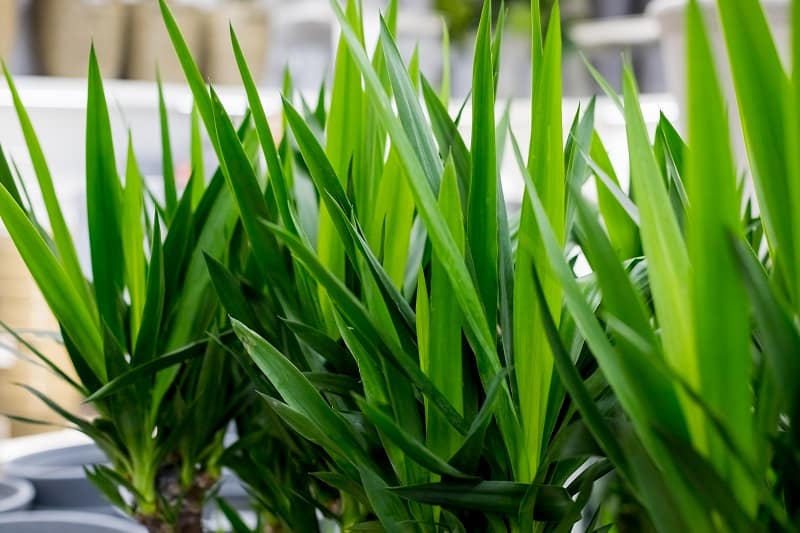
White spots on yucca leaves usually mean there is a problem that needs to be addressed as soon as possible. The white spots can either be due to powdery mildew, spider mites, mealy bugs, or scale insects.
All of these causes can spread from one plant to another, so it is best to act quickly and solve the problem before it infests your entire garden.
The Yucca Plant
The Yucca genus comprises approximately 40 perennial trees, shrubs, and plants. Only some of these are what is commonly known as the yucca plant that is usually grown indoors. They are native to the deserts and semi-deserts of North, South, and Central America, as well as the Caribbean.
Yuccas are slow-growing plants that are also prized for being drought-tolerant and low maintenance.
The most common cause of a dying yucca is overwatering, as with most other succulents, so be sparing and observant when watering. As the yucca plant matures, it will become quite the space-consuming giant, but do not worry as it will take several years to grow to a hard-to-manage size. It grows so slowly that you only really need to repot it every two to three years.
The yucca plant’s size when fully mature will depend on the variety. They like being exposed to full sunlight or bright, indirect sun; this means they will do great on your patio or near a window if inside your house.
These plants like sandy soil that has a pH level of 5.5 to 7.5. Their bloom time is somewhere around the middle of summer or the early weeks of fall. Their flowers are either pink or white in color.
Be aware that this plant can be toxic to some animals, so make sure you do not have them near pets like reptiles that might nibble on the leaves. There have also been cases of yucca plants causing skin irritation to humans.
White Spots on Yucca Leaves
Powdery mildew
One of the most common causes of white spots or substances on your yucca, or on succulents in general, is powdery mildew.
The mildew will look like white spots in its early stages, but will take over as it spreads more and more over the leaves, especially if it is not treated as soon as possible.
Powdery mildew will grow on your yucca plant if it is in a perpetually moist environment or if there are constant fluctuations in temperature. Therefore, make sure the spot you choose for your yucca plant gets a decent amount of sunlight. You can also use neem oil on the plant to remove the powdery mildew.
It is imperative that you keep your other plants away from the infected plant even while you are treating it. Only after a couple of weeks without any powdery white spots on its leaves can you place other plants near it again.
Spider mites/ mealybugs
Spider mites and mealybugs can also cause your yucca plant to have white spots.
The mealybug looks like cotton on the leaf’s surface. It feeds on the plant’s leaves, causing the leaves to become dehydrated, and eventually affects the rest of the plant.
Both spider mites and mealybugs can cause the yucca plant’s leaves to curl, because the constant feeding on it will stress the plant as its nutrients are taken away.
Fortunately, just like with powdery mildew, neem oil is very effective against both of these pests. If you do not have neem oil, you can try rubbing alcohol on a cotton ball and applying it to the plant. This is just as effective as neem oil against the insects.
Just like the powdery mildew, these pests can migrate from one plant to another before you know it, so make sure you isolate your infected plants until you are sure all of the insects have been eradicated.
Scale insects
These insects can reproduce quickly on your yucca plant, especially if the conditions are in their favor. They will feed on the plant’s leaves and you will definitely want to get rid of them as soon as you can.
At first glance, these insects may just look like white spots on your plant’s leaves, but if you look closely, they will appear raised and not aligned with the leaf.
These insects can also cause brown spots to appear on your yucca plant.
Scale insects are not susceptible to most spray insecticides, so you will have to get rid of all of them by hand. You can use rubbing alcohol on a cotton ball, and you need to wipe down all of the plant’s leaves with the alcohol to kill the bugs. While keeping your yucca plant isolated, continue wiping down the leaves with alcohol every few days if you keep seeing the white spots.
If, after a few days, the white spots have disappeared, you can place the plant back with the others, but it is important that you check the leaves from time to time to ensure you do not risk a reinfestation.
Conclusion
When you find white spots on your yucca plant’s leaves, this is cause for concern and you should address it immediately.
The most probable causes of these white spots are powdery mildew, spider mites, mealy bugs, or scale insects.
You can remove the powdery mildew, spider mites, and mealy bugs with high-quality neem oil.
Wiping down the leaves with rubbing alcohol on a cotton ball or swab can take care of scale insects, mealy bugs, and spider mites as well.
While you are treating your yucca plant for any of these conditions, make sure you keep it away from your other plants so they do not get infected.
Thankfully, these problems are easy to remedy and your yucca plant should make a full recovery in no time.
Image: istockphoto.com / undefined undefined